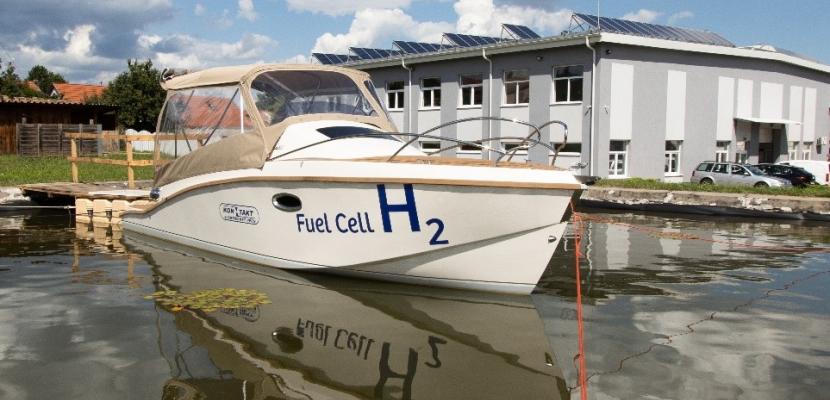Image

Hydrogen fuel cell boat on protected area of Lake Balaton
Published on 08 December 2021

Hungary
Dél-Dunántúl
This is the good practice's implementation level. It can be national, regional or local.
About this good practice
Domestic lakes like Balaton in Hungary are protected areas, and they are used mainly for recreational purposes, so emission-free and low-noise operation of boats and/or ships are important. Battery electric boats are already relatively widespread, but they have short range and complicate to refuel, since port recharging infrastructure is incomplete, and recharging takes a lot of time.
A Hungarian SME in2020 built a prototype of a hydrogen fuel cell (FC) boat with capacity of 8 persons, with a 15 kW FC. The FC stack was purchased from an OEM, but all the system integration work was carried out by the SME, where they transformed a battery electric boat into a hydrogen FC. Cruising time of the boat has been approx. doubled with the FC drivetrain, while still has zero emission.
Early adopters could be e.g water management directorate, nature conservation authority or water police, who drives regularly on the lake. Moreover, the domestic SME develops skills to be able to use and integrate fuel cell even until 300kW range, which could be used even in larger ships and/or Balaton’s ferry service. So, a complete FC boat product-series can be built in longer term and could be potentially extended to other domestic lakes or rivers. Coastal hydrogen refuelling infrastructure needs to be installed. Some of the HRS-s are intended to be built alongside the lake, so it might help to decarbonize the road transport as well. The multi-purpose refuelling infrastructure would be cost-effective
A Hungarian SME in2020 built a prototype of a hydrogen fuel cell (FC) boat with capacity of 8 persons, with a 15 kW FC. The FC stack was purchased from an OEM, but all the system integration work was carried out by the SME, where they transformed a battery electric boat into a hydrogen FC. Cruising time of the boat has been approx. doubled with the FC drivetrain, while still has zero emission.
Early adopters could be e.g water management directorate, nature conservation authority or water police, who drives regularly on the lake. Moreover, the domestic SME develops skills to be able to use and integrate fuel cell even until 300kW range, which could be used even in larger ships and/or Balaton’s ferry service. So, a complete FC boat product-series can be built in longer term and could be potentially extended to other domestic lakes or rivers. Coastal hydrogen refuelling infrastructure needs to be installed. Some of the HRS-s are intended to be built alongside the lake, so it might help to decarbonize the road transport as well. The multi-purpose refuelling infrastructure would be cost-effective
Resources needed
The prototype development was self-financed and costed approx. 200,000 EUR, and took ~12 man-months. Planned market entry and upscale (fleet production in a pilot project, and permitting) estimated to 3.5 – 4.5 million EUR.
Evidence of success
The HFC boat has been showcased in several exhibitions in Hungary and attracted considerable interest both from customer and professional side. Domestic battery electric boat manufacturing is strong and has realised the pros of the HFC drivetrain. Its market entry will gain momentum, because it’s not just the developer who stands up for the project. Due to important emission-free operation on our protected lakes, both the policy makers and local authorities are in favour of the project.
Potential for learning or transfer
Other countries have considerable battery electric boat manufacturing capacities, and this can serve as a good basis to integrate hydrogen fuel cells into these boats. Consequently, smaller companies (SMEs) can also establish such projects and developments. Besides, several lakes or rivers are country-borders, so cross-border projects with HFC inland shipping could be established relatively easy, and the more widespread application can increase the utilization of the hydrogen refuelling infrastructure.
Water authorities, environmental inspectorates, water police operate more or less the same way in different lakes in the EU. These can be always useful for early adopters of the hydrogen FC shipping, since they usually return to the same point, where they started. These ports can be good locations for the first coastal hydrogen refuelling stations, where the technology can be validated, and can serve as starting point for further expansion.
Water authorities, environmental inspectorates, water police operate more or less the same way in different lakes in the EU. These can be always useful for early adopters of the hydrogen FC shipping, since they usually return to the same point, where they started. These ports can be good locations for the first coastal hydrogen refuelling stations, where the technology can be validated, and can serve as starting point for further expansion.
Further information
Website
Good practice owner
You can contact the good practice owner below for more detailed information.
Organisation
KONTAKT-Elektro Ltd

Hungary
Dél-Dunántúl
Contact
project manager